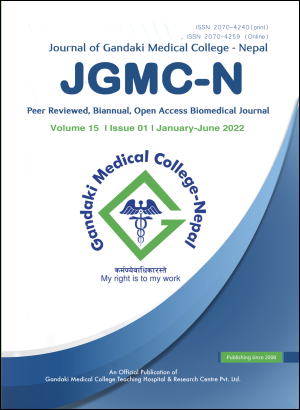Clinico-epidemiological study on animal bite presenting to a tertiary care hospital in western part of Nepal
DOI:
https://doi.org/10.3126/jgmcn.v15i1.44791Keywords:
Animal bite, epidemiological variation, rabies, vaccinationAbstract
Introduction: Animal bite is a common public health problem and dog bites are most common among them in Nepal. Rabies infection is of most significant concern following animal-bites’ injuries. This study aimed to assess the epidemiological variation in terms of demographic variables, type of animal, circumstances of bite, type and site of wound and outcome of the animal bite.
Methods: It was a descriptive cross-sectional study conducted at emergency department of Gandaki Medical College Teaching Hospital and Research Centre among animal-bite cases from October 1, 2020 to September 30, 2021 using a pre-designed questionnaire.
Results: Out of total 217 cases of animal-bite included in the study, 65 (29.95%) were of 21 to 30 years and 129 (59.46%) were males, 120 (55.23%) cases hailed from rural area and 63 (29.03%) were farmers. Most cases 168 (77.42%) were bitten by dog among which 93 (55.35%) were owned dogs and only 22 dogs were vaccinated. A total of 127 (58.53%) were unprovoked and lower limb 130 (59.91%) was the commonest site. World Health Organization (WHO) Category II wound were the most commonly encountered 122 (56.22%). Majority 99 (45.62%) came to hospital within 25 to 48 hours of bite and after cleaning the wound site 115 (52.99%). Only 81 (37.78%) animals were observed for 10 days after the bite out of which 5 (6.09%) developed signs of rabies.
Conclusions: Animal bite was common in males and source was owned dogs. Majority of the owned dogs were not vaccinated and most of the cases visited hospital without following first-aid measures.
Downloads
Downloads
Published
How to Cite
Issue
Section
License
Copyright (c) 2022 Saroj Pokhrel, Roshan Yadav, Karuna Sharma, Abhishek Shrestha, Rekha Poudel, Chandra Bahadur Pun

This work is licensed under a Creative Commons Attribution-NonCommercial 4.0 International License.
This license allows reusers to distribute, remix, adapt, and build upon the material in any medium or format for noncommercial purposes only, and only so long as attribution is given to the creator.

